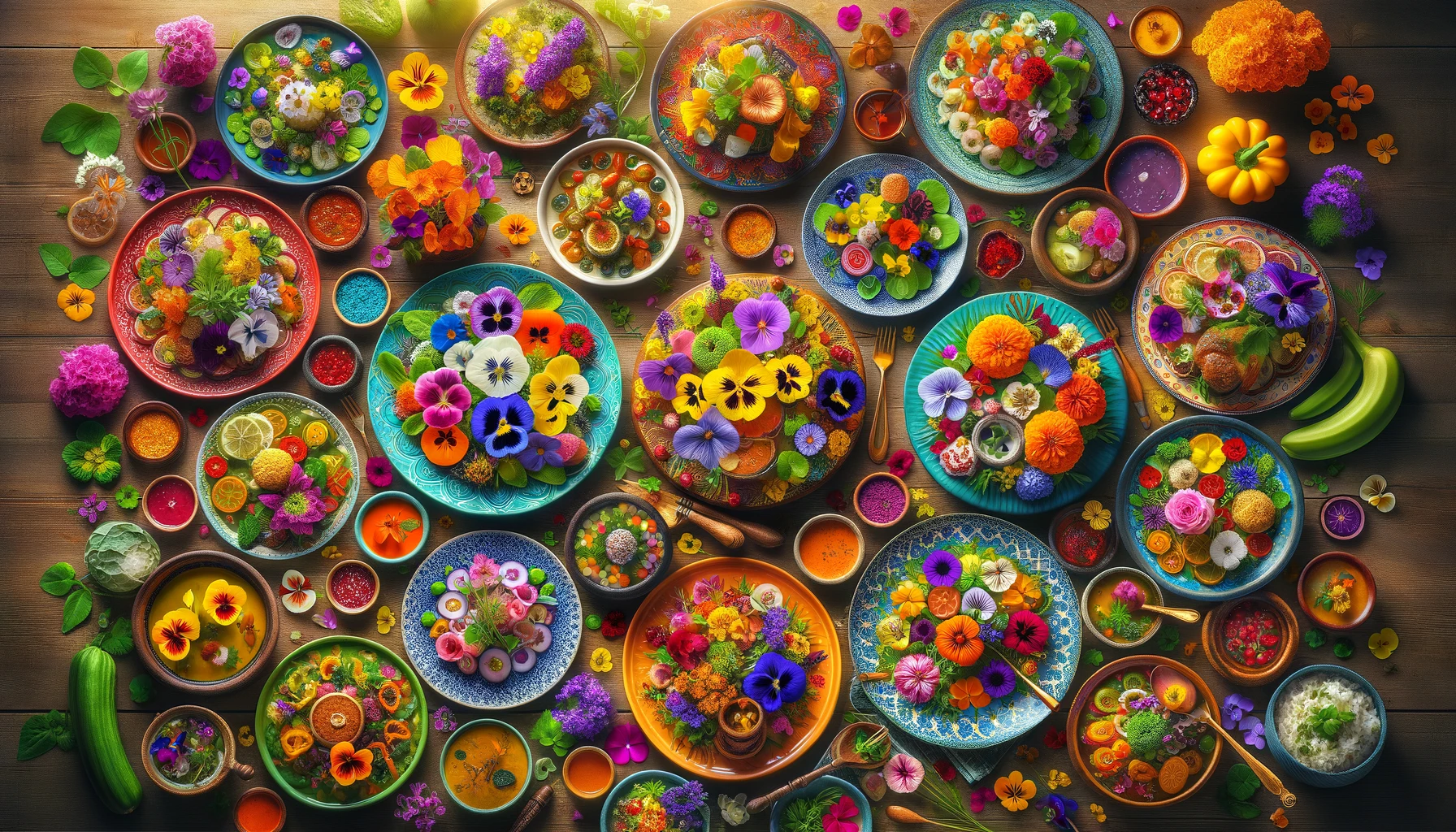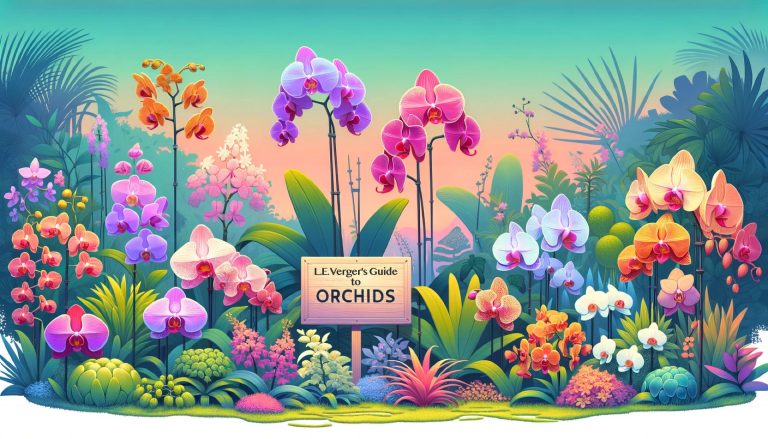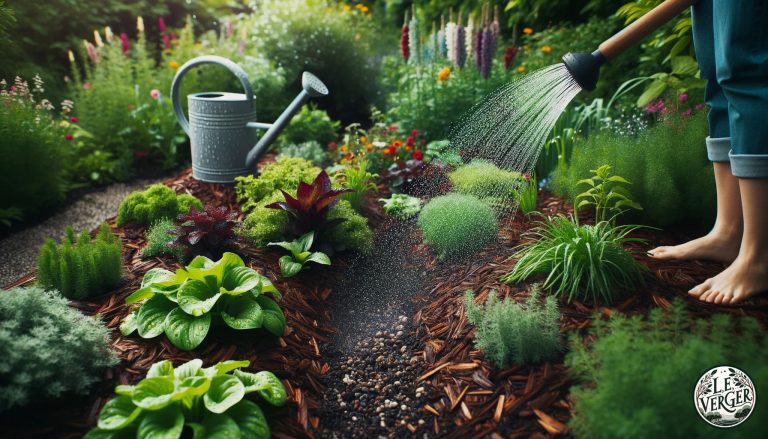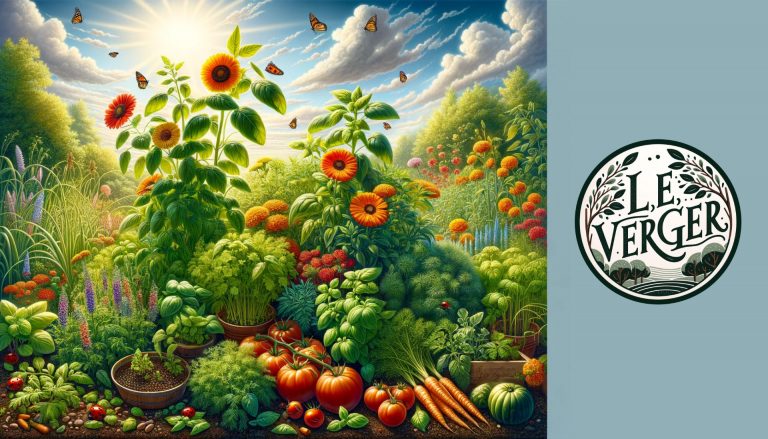Edible Flowers: Adding a Bloom to Your Dishes
Brighten up your meals with the vibrant appeal of edible flowers. Explore types, uses, and benefits in our comprehensive guide.
Edible flowers have been a part of culinary traditions worldwide for centuries. Their allure lies in their vibrant colours, delicate forms, and ability to transform a simple dish into an extraordinary culinary experience. Whether used for their aesthetic appeal, unique flavours, or health benefits, edible flowers offer a delightful way to add a bloom to your dishes.
Your Guide to Edible Flowers
In recent years, there has been a resurgence in the use of edible flowers in modern cuisine. These natural beauties are returning from high-end restaurants to home kitchens, inviting chefs and home cooks alike to explore their culinary potential.
This article will guide you through the exciting world of edible flowers, covering everything from the types you can use to their various culinary applications, health benefits, and tips for growing them at home.
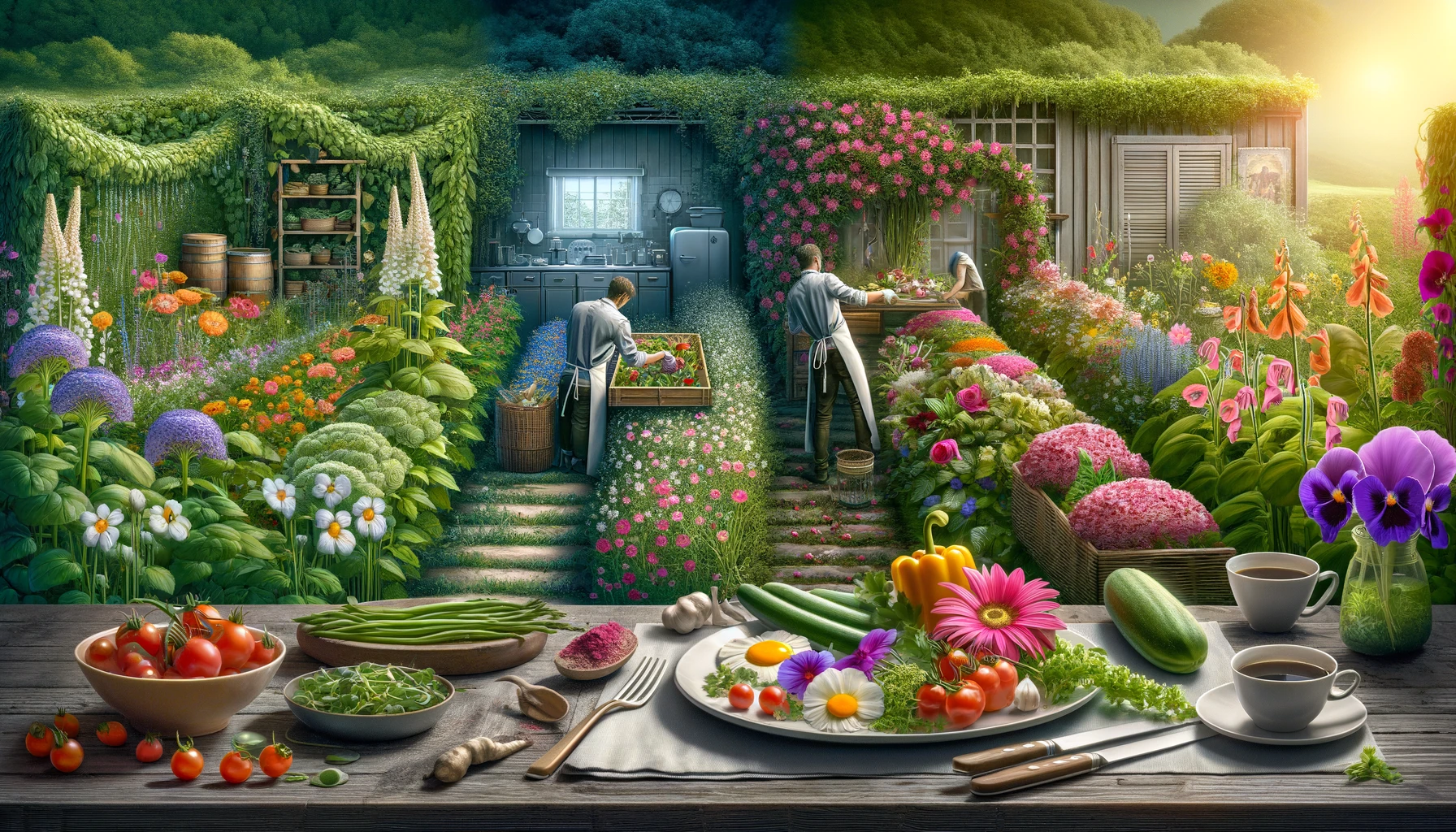
Types of Edible Flowers
When venturing into the world of edible flowers, knowing which blooms are safe to eat and how they can enhance your culinary creations is essential. Here are some popular types of edible flowers that are not only beautiful but also offer unique flavours:
It’s essential to source edible flowers from organic sources or grow them yourself to ensure they are free from harmful pesticides. Not all flowers are edible; some can be toxic, so proper identification is vital.
Salad Enhancements with Edible Flowers
Salads are the perfect canvas for showcasing the beauty and taste of edible flowers. Incorporating flowers like nasturtiums, pansies, or borage can transform a simple green salad into a vibrant and flavourful masterpiece.
Nasturtiums add a peppery zest, while pansies introduce a subtle sweetness. Borage, with its cucumber-like taste, offers a refreshing twist. This simple addition not only elevates the aesthetic appeal of salads but also introduces new and exciting flavours.
Desserts Decorated with Flowers
Desserts gain an elegant touch when adorned with edible flowers. Crystallised or fresh violas, roses, and lavender are not just decorative but infuse a gentle, floral flavour. Whether garnishing a chocolate cake with rose petals or topping lemon tarts with tiny viola blooms, these flowers can turn ordinary desserts into exquisite culinary art pieces.
The key is to match the flower’s flavour profile with the dessert for a harmonious blend.
Floral Beverages
Edible flowers can significantly enhance cocktails, teas, and infused waters. Chamomile, lavender, and hibiscus are popular choices, each contributing their unique flavours.
Chamomile adds a calming, slightly sweet taste to teas, while lavender can create an aromatic, sophisticated profile in cocktails. Hibiscus, known for its vibrant colour and tart flavour, is excellent for refreshing summer drinks.
Savoury Creations with Flowers
In savoury dishes, edible flowers can provide an unexpected flavour and colour. Adding chive blossoms or calendula to soups, pasta, or other delicious dishes can elevate the dish’s visual appeal and introduce subtle, complementary flavours.
With their mild onion taste, chive blossoms are delicious in cream-based dishes or as a garnish for soups.
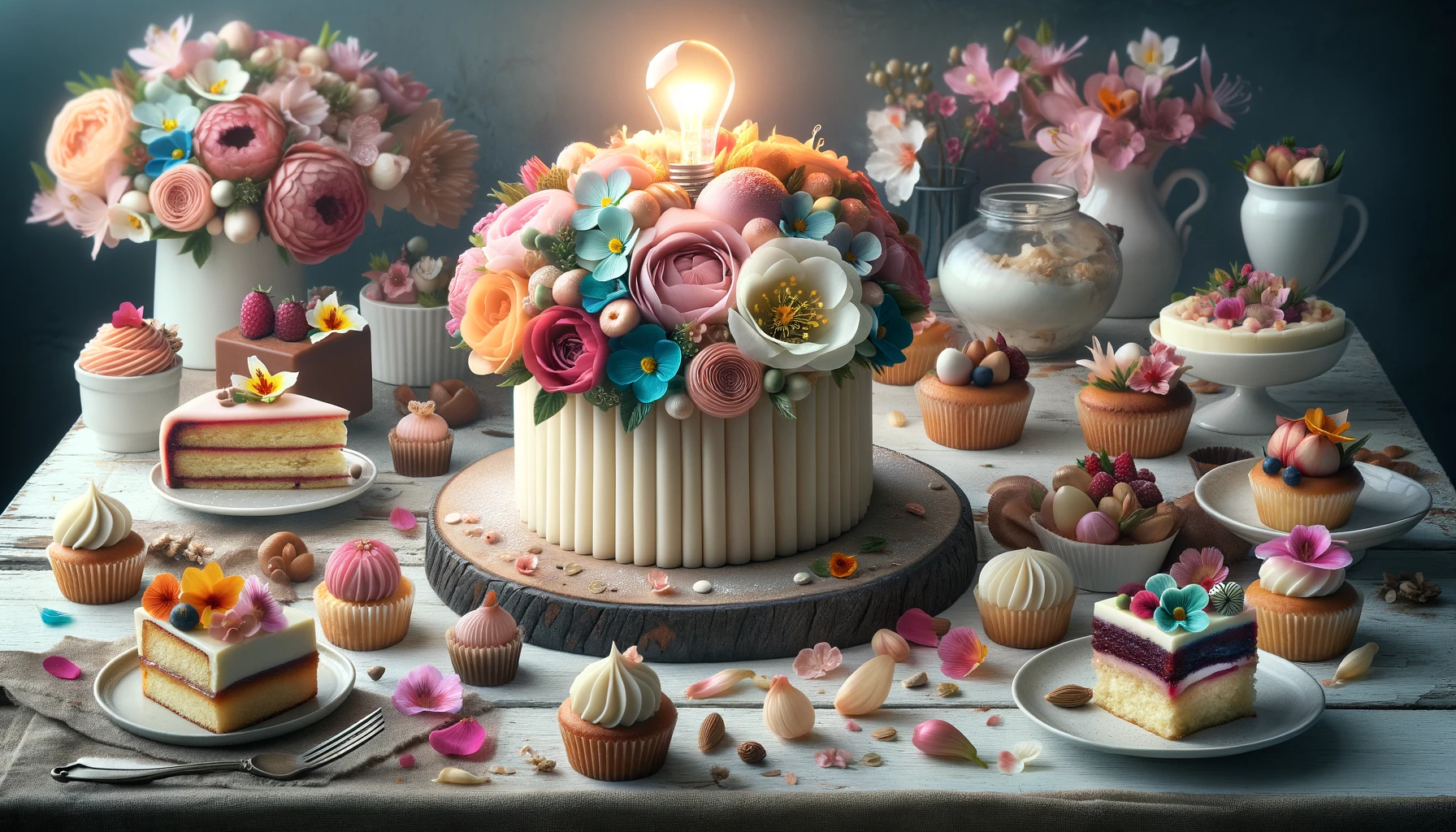
Floral Butters and Cheeses
Butter and soft cheeses can be transformed into gourmet spreads by incorporating finely chopped edible flowers. The petals of roses, lavender, or chive blossoms add colour and infuse these spreads with delicate floral flavours.
This simple addition can make a significant impact, turning an ordinary meal into an elegant dining experience.
Ice Creams and Sorbets with a Floral Twist
Homemade ice creams and sorbets can be infused with the flavours of lavender or rose for a unique floral twist. The key is to balance the floral notes with the sweetness of the dessert, creating a refreshing and sophisticated flavour profile that is both unexpected and delightful.
Infused Vinegar and Oils
Creating infused vinegar and oils with edible flowers is an excellent way to capture their essence in a versatile form. These infusions can be used in dressings, marinades, or as a finishing touch to dishes, adding a subtle floral note that can elevate the overall flavour profile.
Edible Flower Recipes
Nasturtium Caprese Salad
This twist on the classic Caprese salad incorporates nasturtiums dish’s peppery kick. Layer fresh mozzarella and tomato slices, then sprinkle with nasturtium petals and whole leaves. Drizzle with olive oil and balsamic vinegar, and season with salt and pepper. The vibrant colours and bold flavours make this dish a summer favourite.
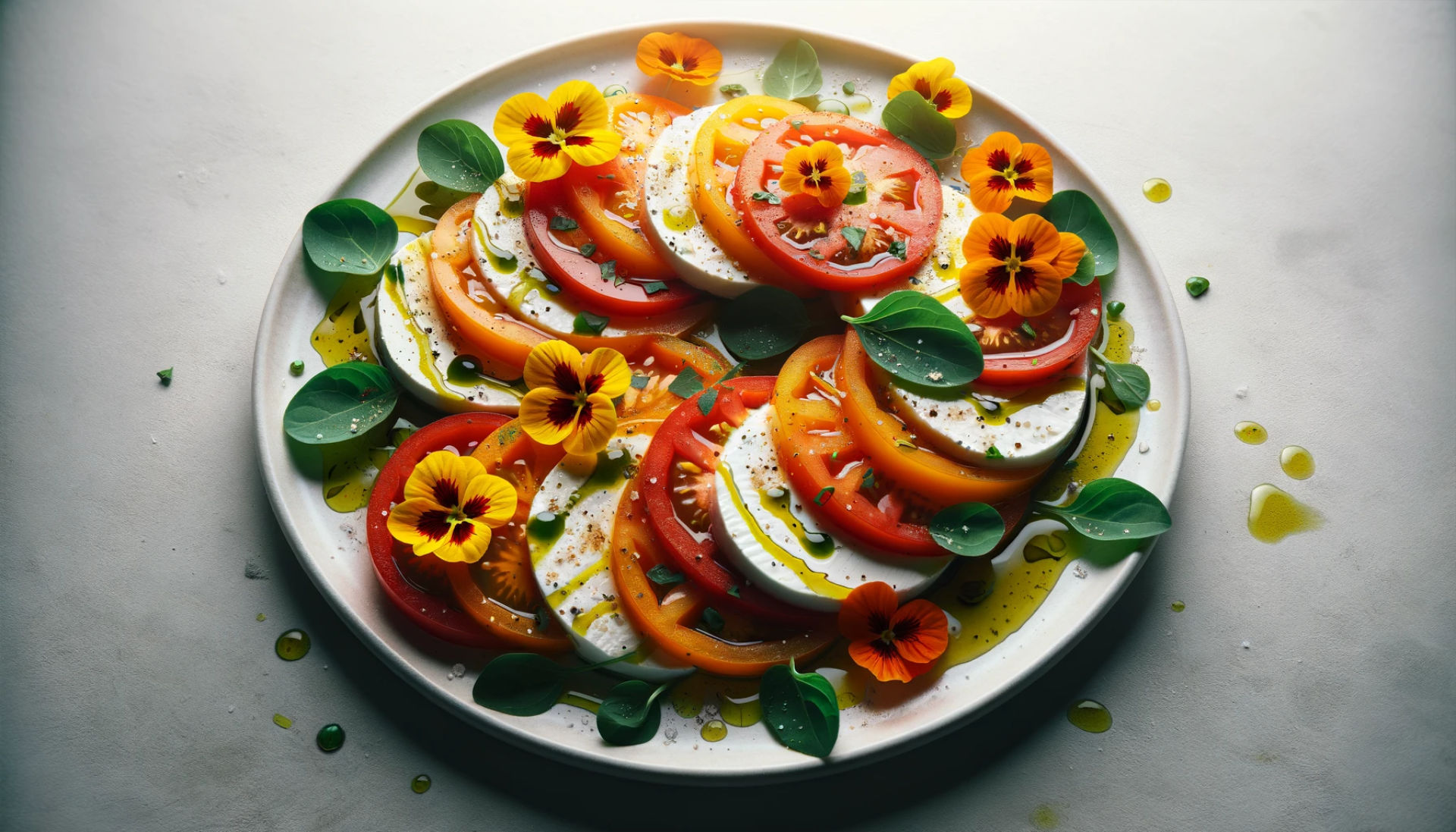
Ingredients:
- Fresh mozzarella cheese, sliced
- Ripe tomatoes, sliced
- Nasturtium petals and whole leaves
- Extra virgin olive oil
- Balsamic vinegar
- Salt, to taste
- Freshly ground black pepper, to taste
Instructions:
- Arrange the Base: Start by arranging alternate slices of fresh mozzarella and ripe tomatoes on a serving platter. This layering not only looks attractive but also allows the flavours to meld together.
- Add Nasturtiums: Sprinkle nasturtium petals and whole leaves over the mozzarella and tomato slices. The peppery taste of nasturtiums is a great counterbalance to the sweetness of the tomatoes and the creamy texture of the mozzarella.
- Drizzle and Season: Drizzle the salad with a good quality extra virgin olive oil and balsamic vinegar. The oil adds a smooth richness while the vinegar brings a slight acidity and sweetness that elevates the overall flavour profile.
- Season to Taste: Finish off by seasoning the salad with salt and freshly ground black pepper. The salt will help in bringing out the natural flavours of the tomatoes and cheese.
- Serve Immediately: This salad is best enjoyed fresh. Serve it immediately to savour the freshness of the ingredients and the vibrant flavours.
Tips:
- Quality of Ingredients: For a salad as simple as Caprese, the quality of ingredients plays a crucial role. Use the best quality mozzarella, ripe and flavourful tomatoes, and high-quality olive oil and balsamic vinegar for the best taste.
- Variations: Feel free to experiment by adding fresh basil leaves or a sprinkle of dried herbs for an additional layer of flavour.
- Serving Suggestions: This salad pairs wonderfully with crusty bread or as a fresh starter to a summer meal.
Lavender-Infused Lemonade
Create a refreshing summer drink by infusing lemonade with lavender. Boil a handful of lavender buds with sugar and water to create a syrup. Strain and mix with freshly squeezed lemon juice and cold water. Serve over ice for a beautifully fragrant and thirst-quenching beverage.
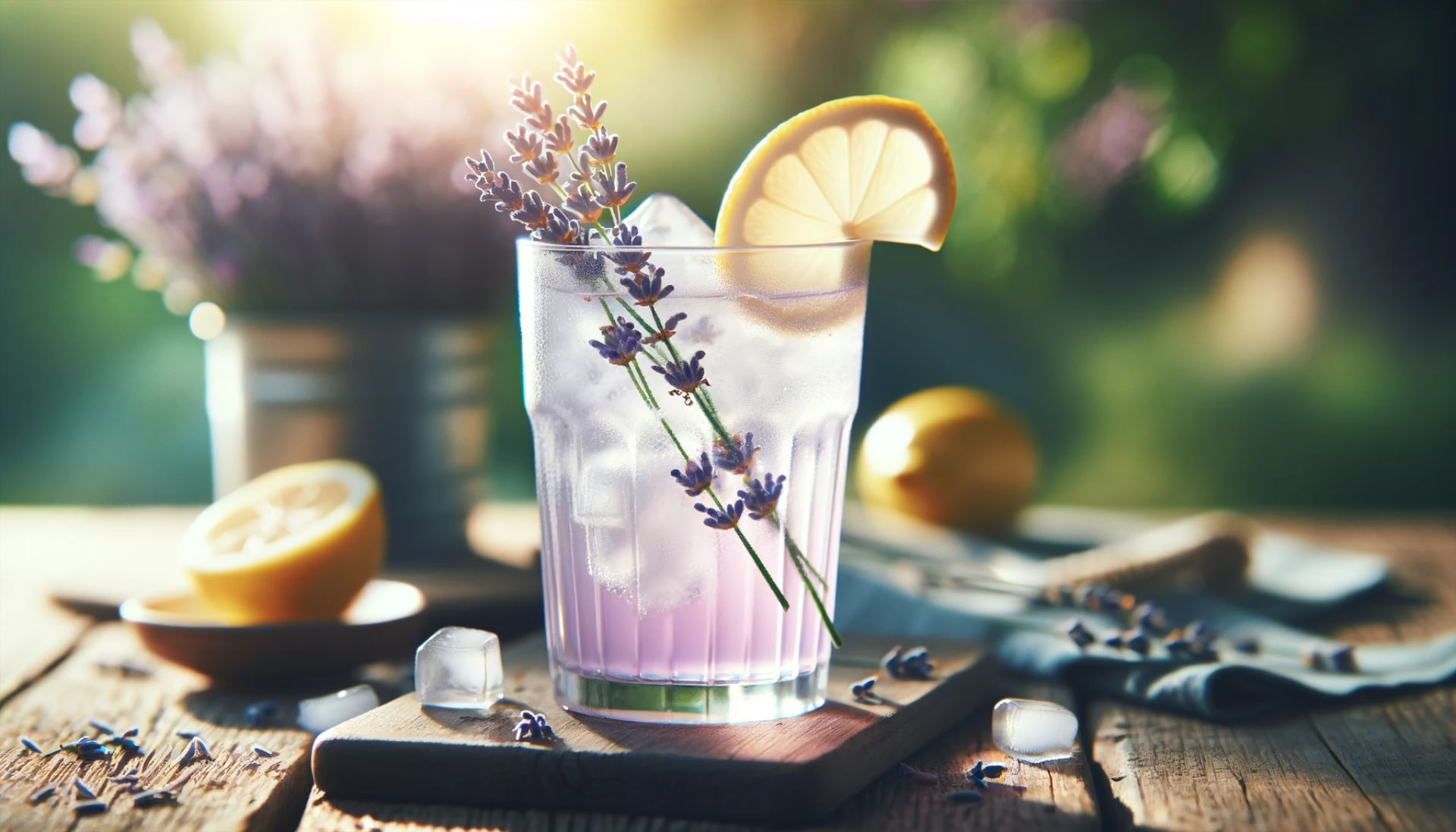
Ingredients
- Fresh lavender buds (1/4 cup)
- Granulated sugar (1 cup)
- Water (2 cups for syrup, additional for lemonade)
- Freshly squeezed lemon juice (1 cup)
- Ice cubes
- Lemon slices and lavender sprigs for garnish
Instructions
- Lavender Syrup: In a saucepan, combine lavender buds, sugar, and 2 cups of water. Bring to a boil, then simmer until the sugar dissolves. Remove from heat and let it infuse for 20 minutes.
- Strain: Strain the syrup to remove lavender buds, ensuring a smooth texture.
- Lemonade Mix: In a large pitcher, combine freshly squeezed lemon juice with the lavender syrup. Add 4 cups of cold water. Stir well.
- Serve: Pour the lemonade over ice in glasses. Garnish with lemon slices and a sprig of lavender.
Serving Suggestion Enjoy this Lavender-Infused Lemonade on a sunny day, perfect as a standalone refreshment or paired with light summer salads and sandwiches.
Rose Petal Jam
This fragrant jam is a delightful addition to any breakfast table. Simmer rose petals with sugar, lemon juice, and a bit of water until thickened. The result is a sweet, floral spread perfect for toast, scones, or as a filling for pastries.
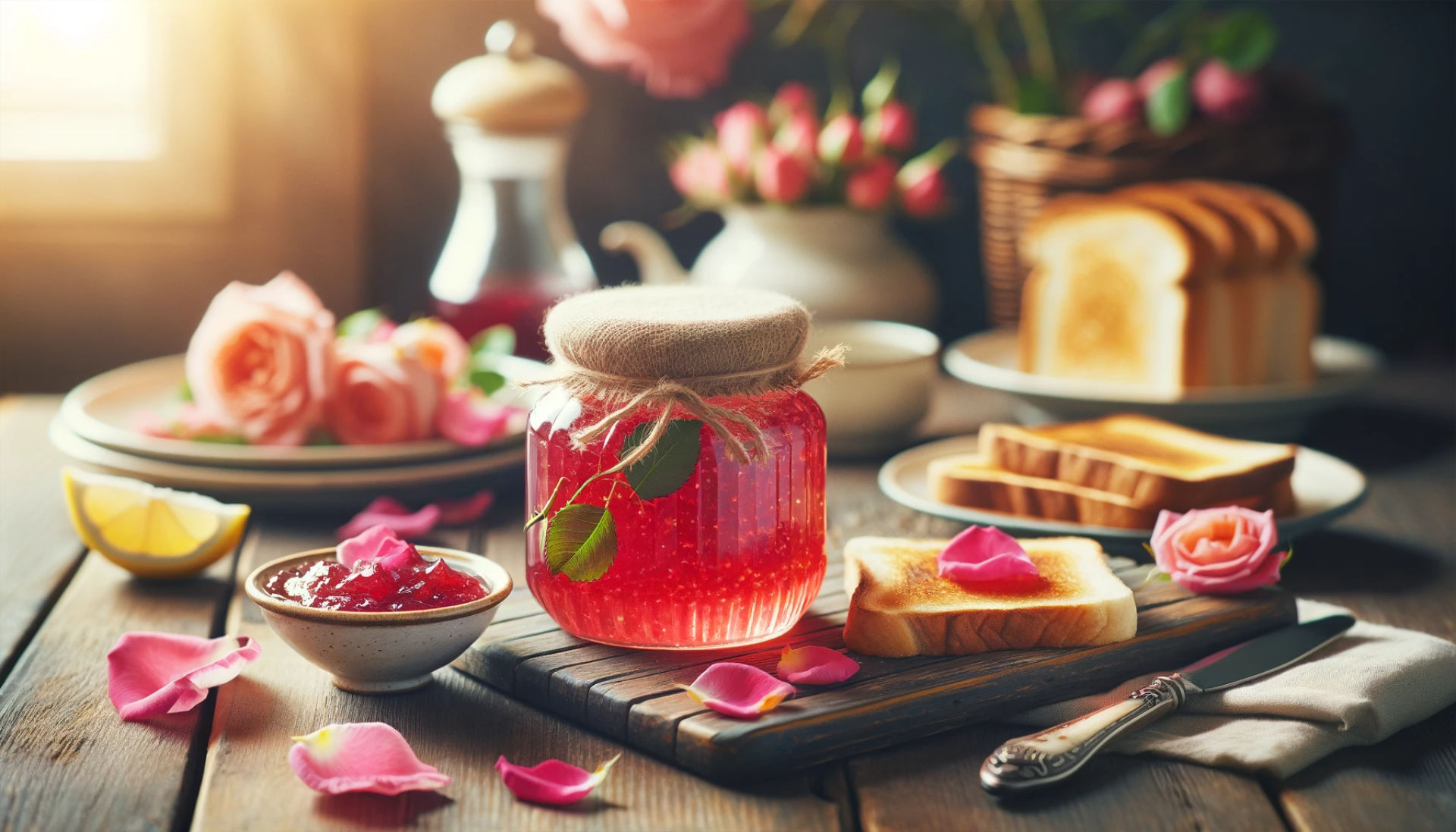
Ingredients:
- 2 cups fresh rose petals (preferably organic and pesticide-free)
- 1 ½ cups granulated sugar
- 3 tablespoons lemon juice
- ¾ cup water
- 1 teaspoon rose water (optional, for enhanced flavour)
Instructions:
- Preparation of Rose Petals: Gently rinse the rose petals in cold water to remove any dirt or debris. Pat them dry with a towel. Trim away the white base of the petals as it can impart bitterness.
- Creating Rose Petal Paste: In a food processor, pulse the rose petals with about half of the sugar until it forms a coarse paste. This helps to release the natural oils and enhances the fragrance.
- Cooking the Jam: In a medium saucepan, combine the rose petal paste, remaining sugar, lemon juice, and water. Stir over medium heat until the sugar completely dissolves.
- Simmering: Reduce the heat to low and let the mixture simmer gently. The mixture will gradually thicken. This may take about 20 to 30 minutes. Stir occasionally to prevent sticking.
- Testing the Jam: To test if the jam is ready, place a small amount on a cold plate. If it gels and doesn’t run, it’s done.
- Final Touch: If using, stir in the rose water at the end for an extra boost of floral flavour.
- Canning: Pour the hot jam into sterilised jars, leaving a bit of space at the top. Seal the jars and let them cool at room temperature.
- Storage: Store in a cool, dark place. Once opened, refrigerate and consume within a month.
Serving Suggestions:
- Spread on toast, scones, or croissants.
- Use as a filling for crepes or pastries.
- Pair with soft cheeses on a cheeseboard.
- Swirl into yoghurt or oatmeal for a floral twist.
Beverage Pairing:
- A cup of Earl Grey tea complements the floral notes of the jam.
- For a brunch setting, a glass of Prosecco or Champagne adds a luxurious touch.
Tip: The colour of your rose petals will impact the colour of your jam. Darker petals yield a deeper hue, while lighter petals result in a more subtle colour. For an even more vibrant colour, a small beetroot can be grated and added during cooking.
Note: Ensure the roses are free from pesticides and safe for consumption. Roses from florists are typically not suitable for this purpose.
Chive Blossom Vinegar
For a subtle onion flavour in your dressings and marinades, infuse vinegar with chive blossoms. Fill a jar with fresh chive flowers, then pour over white wine or apple cider vinegar for a couple of weeks, then strain. The infused vinegar is excellent in salad dressings or for deglazing pans.
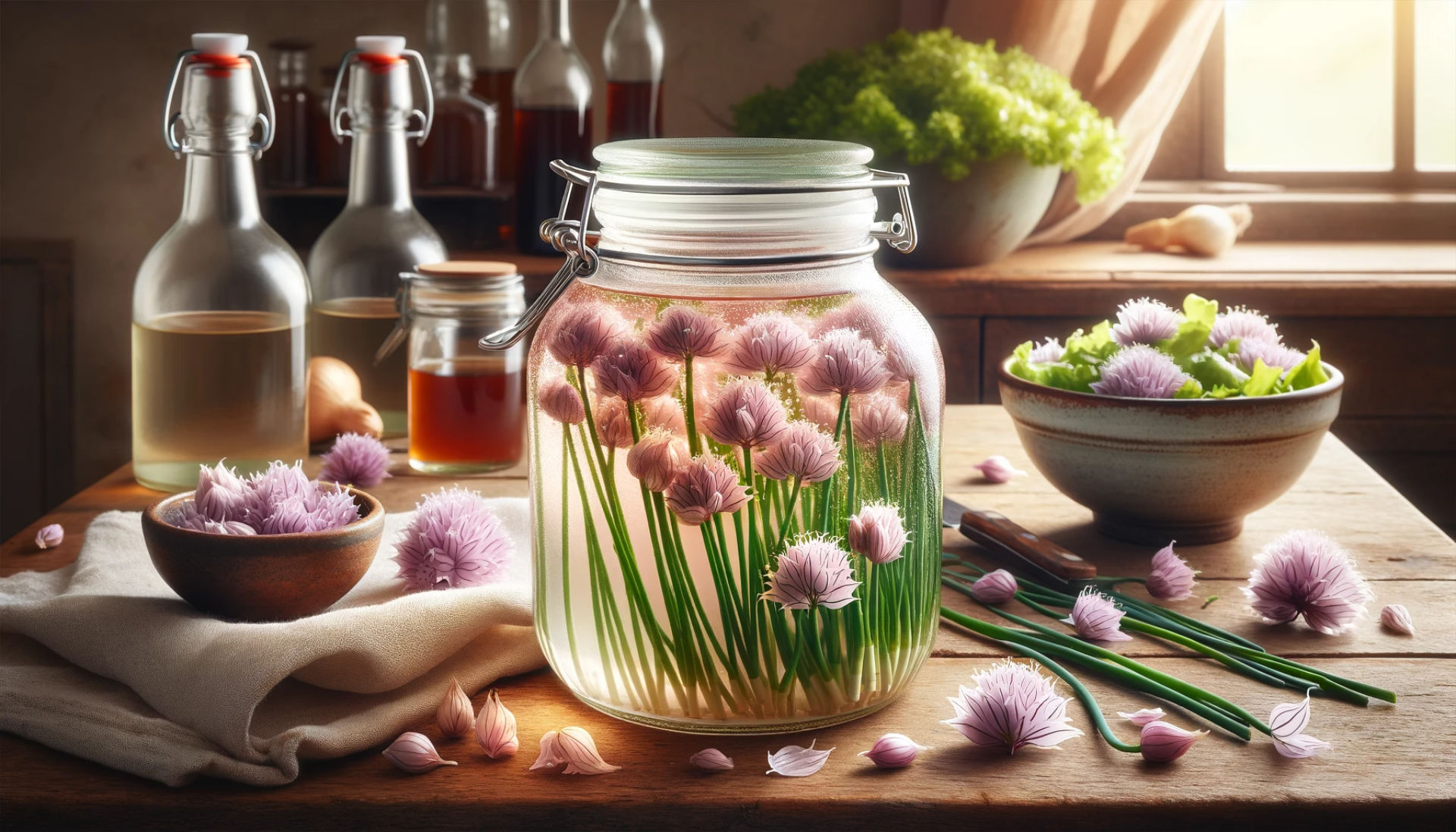
Ingredients
- Fresh chive blossoms: 1 cup (lightly packed)
- White wine vinegar or apple cider vinegar: 2 cups
Equipment
- Clean, dry jar with a tight-fitting lid
- Fine mesh strainer or cheesecloth
- Small funnel (optional)
Instructions
- Preparation of Chive Blossoms: Gently rinse the chive blossoms to remove any dirt or small insects. Pat them dry with a clean towel or let them air dry completely. This step is crucial to prevent mould growth during infusion.
- Jar Filling: Fill your jar with the prepared chive blossoms. They should be loosely packed, allowing space for the vinegar to circulate.
- Adding Vinegar: Pour the white wine or apple cider vinegar over the blossoms until they are completely submerged. If using a funnel, ensure it’s clean and dry to avoid contamination.
- Sealing and Storing: Tightly seal the jar. Store it in a cool, dark place for about 2 weeks. A cupboard away from direct sunlight is ideal.
- Checking and Shaking: Check the jar every few days and give it a gentle shake to ensure even infusion.
- Straining the Vinegar: After 2 weeks, strain the vinegar through a fine mesh strainer or cheesecloth into a clean bottle or jar. This removes all the chive blossoms, leaving you with a beautifully infused vinegar.
- Storage: Store your chive blossom vinegar in a cool, dark place. It can be refrigerated to extend its shelf life.
Serving Suggestions
- Salad Dressings: Use it as a base for vinaigrettes, adding an understated onion note.
- Marinades: Incorporate it into marinades for chicken or vegetables for a subtle flavour enhancement.
- Deglazing: Perfect for deglazing pans after sautéing meats or vegetables.
Note
- The colour of the vinegar may change to a light pink hue, which is natural and adds to its visual appeal.
- Ensure your jar and utensils are thoroughly clean to prevent any spoilage.
Candied Violas for Desserts
Candied violas are a beautiful and sweet decoration for cakes and desserts. Brush viola flowers with beaten egg whites, then sprinkle with superfine sugar. Let them dry, and use them to embellish desserts for a touch of elegance.
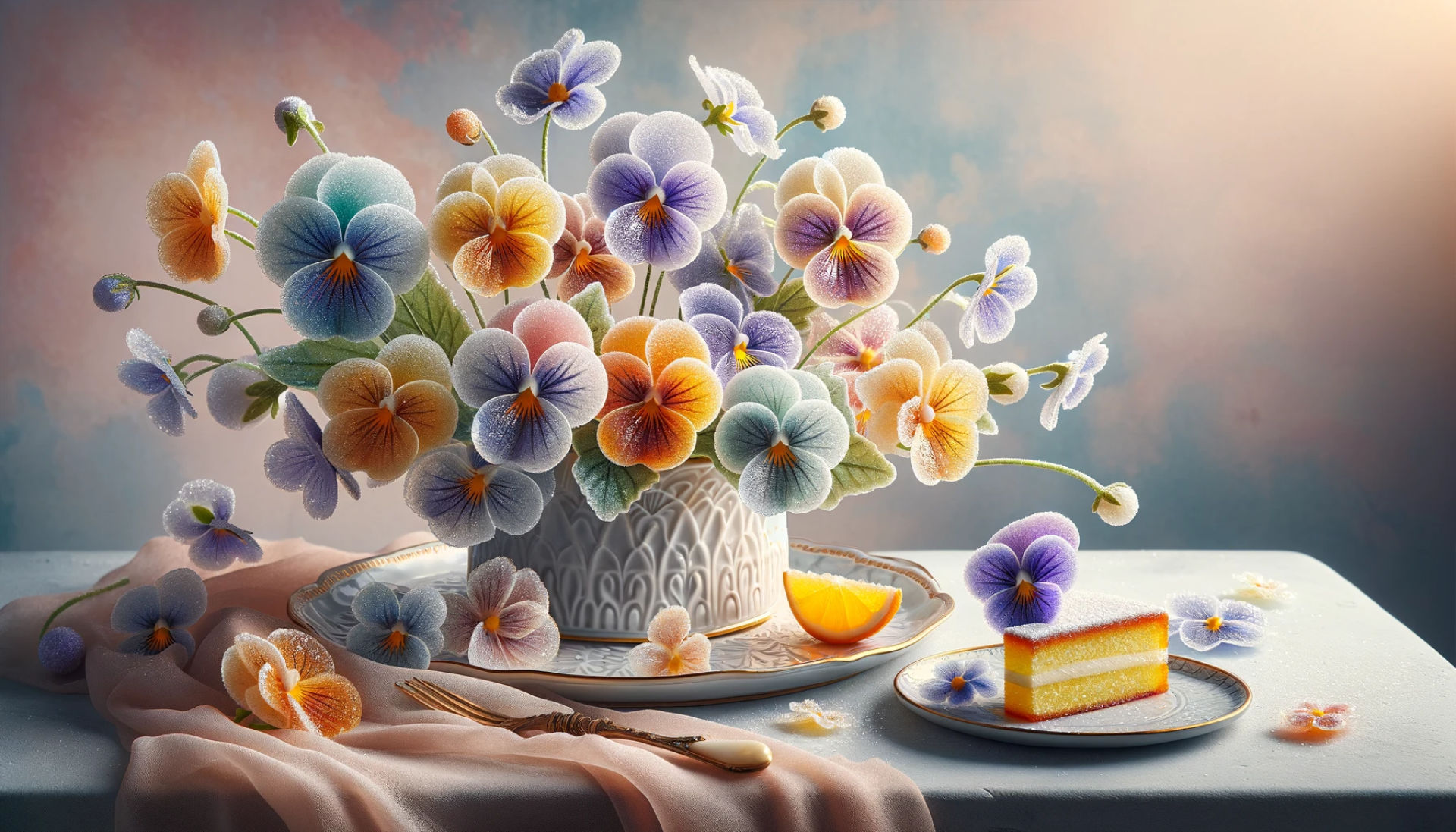
Ingredients
- Fresh violas (pansies can also be used): 20-30 flowers
- Superfine sugar (also known as caster sugar): 1/2 cup
- Egg whites from 1 large egg
Equipment
- Small paintbrush (food-safe)
- Wire rack
- Parchment paper
Instructions
- Preparation of Violas: Ensure that the violas are organically grown and pesticide-free. Gently rinse them under cold water and let them air dry completely on a paper towel.
- Beating Egg Whites: Lightly beat the egg whites until they are slightly frothy. Avoid over-beating as you need a thin consistency for brushing.
- Coating with Egg Whites: Hold a viola by the stem and use the paintbrush to gently coat both sides of the petals with egg white. Be thorough but gentle to avoid damaging the delicate petals.
- Sprinkling Sugar: Over a bowl, sprinkle the superfine sugar evenly over both sides of the flower. Ensure a light but consistent coverage.
- Drying: Place the sugar-coated violas on a wire rack lined with parchment paper. Allow them to dry in a warm, dry place for 12-24 hours until they are hard and crisp.
- Storage: Once completely dry, store the candied violas in an airtight container, layered between sheets of parchment paper. They can last up to 3 months if stored in a cool, dry place.
Serving Suggestions
- Cake Decoration: Adorn cakes, especially those with light flavours like lemon or vanilla, with these candied flowers.
- Dessert Garnish: Use them to garnish desserts such as puddings, mousses, or custards for an added visual appeal.
- Cocktail Accents: Float them in cocktails or mocktails for an elegant touch.
Note
- Ensure the violas are edible and not treated with chemicals.
- Superfine sugar is preferred for its fine texture, which coats the flowers more delicately than regular granulated sugar.
Squash Blossom Fritters
Dip squash blossoms in a light batter for a savoury treat and fry until golden. The blossoms can be stuffed with herbed cheese or enjoyed plain. Serve with a dipping sauce for a delightful appetizer or snack.
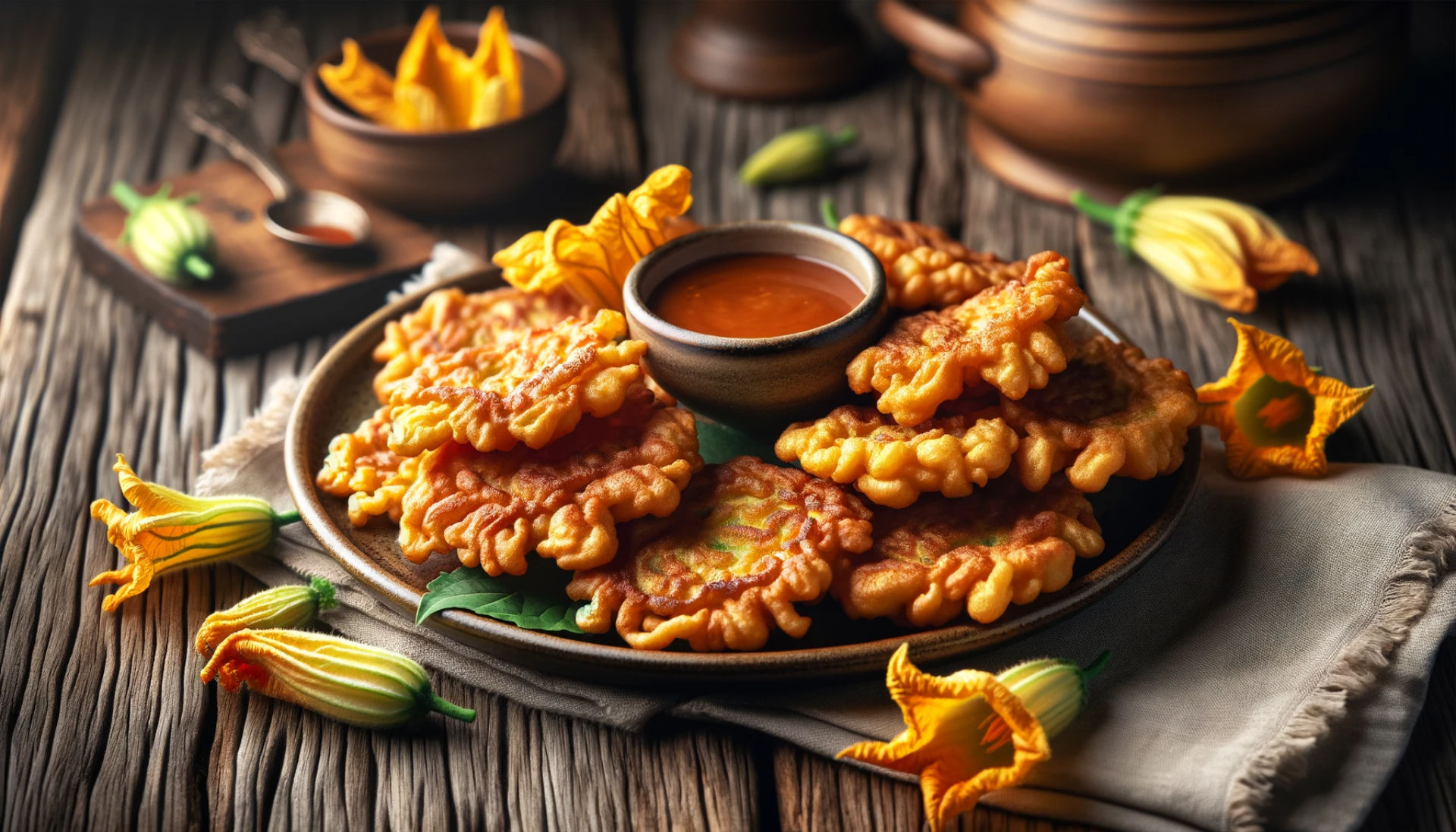
Ingredients
- Fresh squash blossoms: 12-15 blossoms
- All-purpose flour: 1 cup
- Cold water or beer: 3/4 cup
- Egg: 1 large
- Salt: 1/2 teaspoon
- Black pepper: 1/4 teaspoon
- Herbed cheese (optional for stuffing): 1/2 cup
- Vegetable oil for frying
Equipment
- Deep frying pan or skillet
- Mixing bowl
- Whisk
Instructions
- Preparing Squash Blossoms: Gently rinse the squash blossoms and pat them dry. Remove the stamens from inside the blossoms. If stuffing, carefully open the petals and spoon a small amount of herbed cheese inside each blossom.
- Making the Batter: In a mixing bowl, whisk together flour, salt, and pepper. Add the egg and cold water (or beer) to the dry ingredients. Whisk until the batter is smooth and free of lumps.
- Heating Oil: In a deep frying pan, heat the vegetable oil to 375°F (190°C). The oil should be deep enough to submerge the blossoms.
- Dipping and Frying: Dip each blossom in the batter, ensuring it’s fully coated. Carefully place the coated blossoms in the hot oil. Fry in batches to avoid overcrowding, turning once, until golden brown (about 2-3 minutes per side).
- Draining: Remove the fritters with a slotted spoon and drain on paper towels.
- Serving: Serve hot with your choice of dipping sauce, like a light aioli or marinara.
Serving Suggestions
- Appetizer Platter: Arrange on a platter with a variety of dipping sauces.
- Light Meal: Pair with a fresh salad for a light, summery meal.
Note
- Be gentle when handling squash blossoms as they are quite delicate.
- The batter should be light; avoid making it too thick.
Health Benefits of Edible Flowers
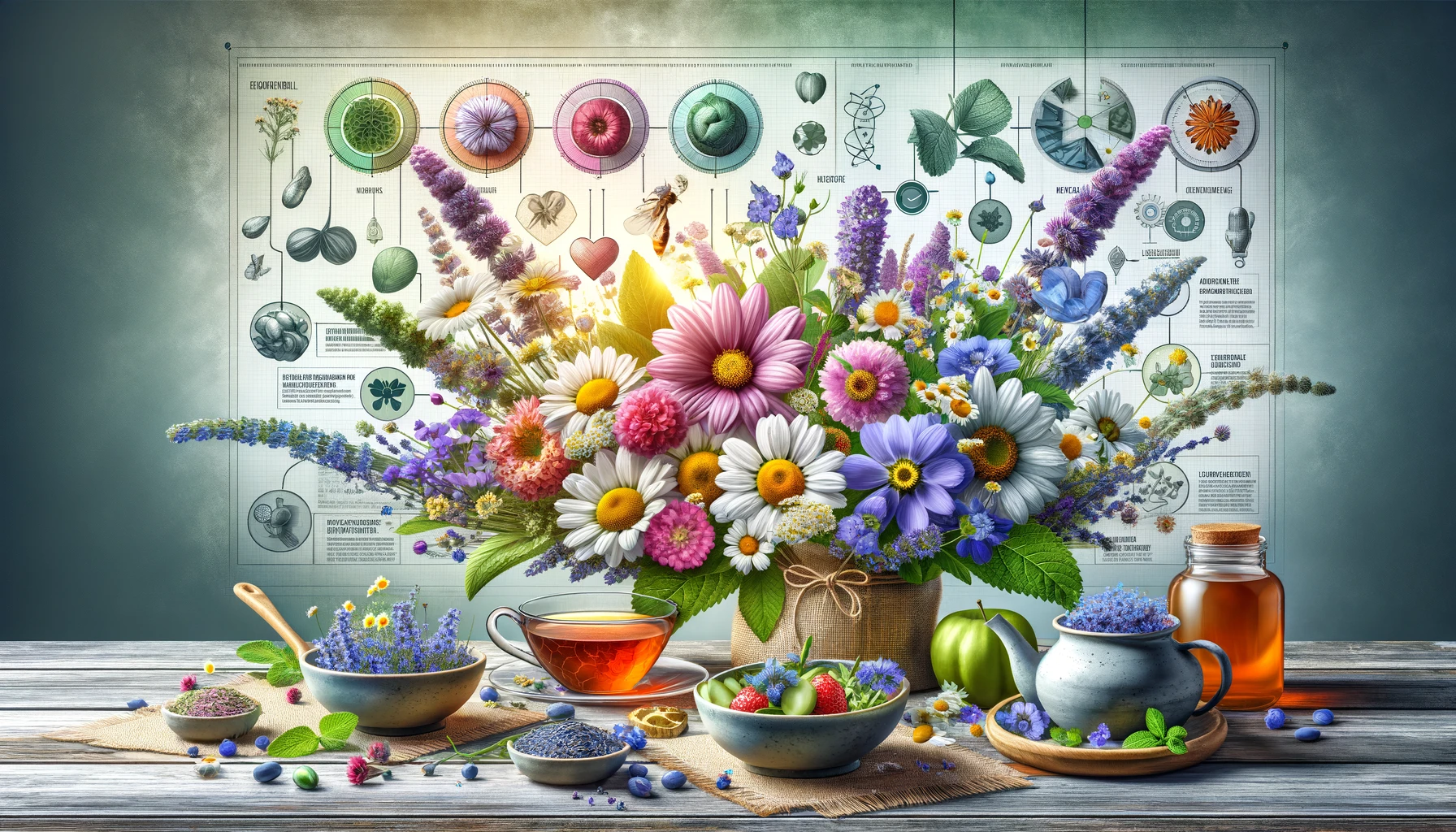
Nutritional Value and Antioxidants
Many edible flowers are not just pleasing to the eye; they are also rich in nutrients and antioxidants. For example, flowers like nasturtiums and marigold (calendula) are high in vitamins A and C, which are essential for immune health and skin vitality.
The vibrant colours of these flowers indicate the presence of potent antioxidants like flavonoids and carotenoids, which help combat oxidative stress and inflammation in the body.
Digestive and Herbal Remedies
Some edible flowers, such as chamomile and lavender, have long been used in herbal medicine for their digestive and calming propertit’s Chamomile is renowned for its ability to soothe the digestive system and promote relaxation, making it an excellent choice for teas.
Conversely, lavender is known for its stress-reducing and sleep-inducing effects, which can indirectly benefit digestion and overall well-being.
Heart Health and Anti-Inflammatory Properties
Flowers like hibiscus and roses are noted for their heart health benefits. Hibiscus, in particular, has been shown to help lower blood pressure and cholesterol levels, thanks to its bioactive compounds. Similarly, roses are believed to have anti-inflammatory properties, which can support heart health by reducing the risk of chronic diseases.
Skin Health and Beauty Benefits
Edible flowers like rose and calendula are also popular in skincare, owing to their anti-inflammatory and soothing properties. Rose petals, for instance, can help hydrate and tone the skin, while calendula is often used in products for its healing and calming effects, particularly for sensitive or irritated skin.
Mental Health and Cognitive Benefits
Certain edible flowers, such as lavender and rosemary flowers, have been linked to cognitive and mental health benefits. The aroma of lavender, for example, is widely recognised for its calming effects and has been used in aromatherapy to reduce anxiety and improve mood.
While not commonly eaten in its floral form, Rosemary is known for its memory-enhancing properties, attributed to compounds like rosmarinic acid.
Growing Edible Flowers

Starting Your Edible Flower Garden
Growing edible flowers at home is a rewarding way to ensure you have a fresh, organic supply for your culinary needs. To start, choose a sunny spot in your garden or balcony. Most edible flowers, like calendula, nasturtiums, and pansies, thrive in well-draining soil and full to partial sunlight. If space is limited, consider container gardening, which works well for smaller plants like violas and chive blossoms.
Choosing the Right Flowers
Select flowers that you enjoy both visually and gastronomically. Research the growing conditions each flower prefers. For instance, lavender requires well-draining soil and plenty of sunlight, while borage prefers richer soil and can tolerate more moisture. It’s also crucial to source your seeds or plants from organic suppliers to ensure they are safe for consumption.
Planting and Maintenance
When planting your edible flowers, pay attention to spacing and depth requirements. Regular watering and occasional fertilising with a gentle, organic fertiliser will promote healthy growth. However, be careful not to over-fertilise, as this can reduce the flowers’ flavour intensity.
Pest Control and Organic Practices
Adopting organic gardening practices is vital when growing edible flowers. Use natural pest control methods, such as companion planting or introducing beneficial insects, to keep your plants healthy without the use of harmful chemicals.
Harvesting and Storage
Harvest your edible flowers in the morning when their essential oils are at their peak. Gently rinse them and pat dry. If you’re not using them immediately, store them in a moist paper towel inside a sealed container in the refrigerator. Most flowers are best used fresh, but some, like calendula and lavender, can be dried for longer storage.
Safety Tips for Edible Flowers
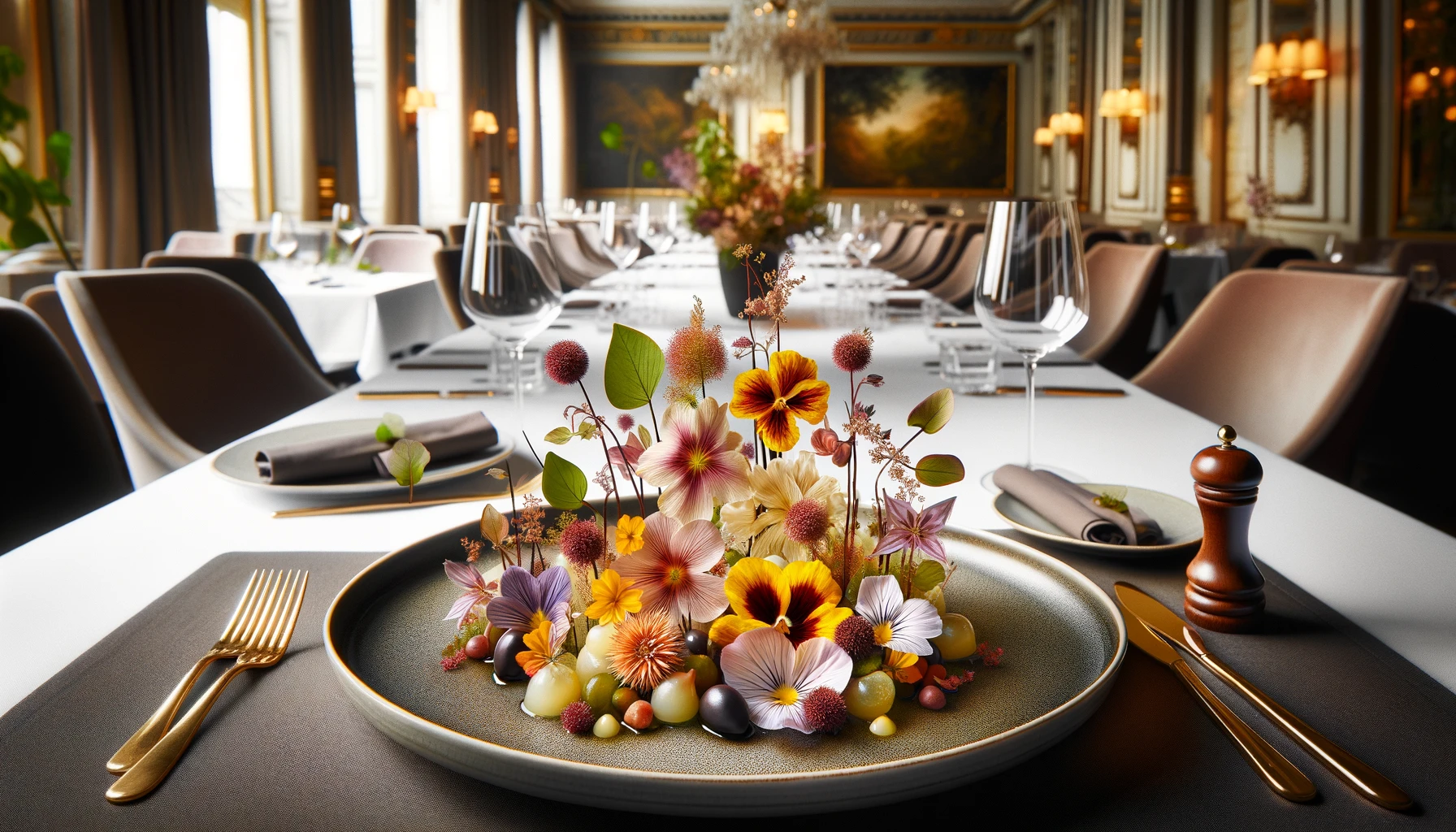
Proper Identification and Sourcing
The most crucial aspect of consuming edible flowers is to ensure proper identification. Misidentifying flowers can lead to consuming toxic varieties. Always It’sa reliable guide or source your flowers from a reputable supplier. Avoid picking flowers from the wild unless you are absolutely certain about their identity and safety.
Avoiding Contaminated Areas
Never consume flowers that have been exposed to pesticides or herbicides. This is particularly important if you are foraging flowers from areas that are not designated for organic gardening, verges or public parks.
Allergy Precautions
If you or anyone who will be consuming the flowers has plant allergies, especially to pollen, proceed with caution. Introduce new edible flowers gradually and in small quantities to monitor for any allergic reactions.
Culinary Use and Moderation
While edible flowers add flavour and aesthetic appeal to dishes, they should be used in moderation. Some flowers can have a laxative effect or interfere with medication if consumed in large quantities.
Preparation and Cleaning
Before using edible flowers, rinse them gently under cold water to remove any dirt or insects. Pat them dry with a paper towel. For flowers with larger blooms, like roses or squash blossoms, remove the pistils and stamens, as these parts can be bitter.
Pregnancy and Medical Conditions
Pregnant women and individuals with certain medical conditions should consult a doctor before consuming edible flowers, as some varieties can have contraindications with specific health conditions or medications.
Conclusion
Incorporating edible flowers into your cooking adds visual appeal and new and exciting flavours to your dishes. From salads and beverages to jams and desserts, these natural beauties offer endless possibilities to enhance your culinary creations. Remember to follow safety guidelines and enjoy the unique taste and beauty that edible flowers bring to your table.
FAQs
- Can all flowers be eaten? No, not all flowers are edible. Some are toxic. Always ensure proper identification and source from reliable suppliers.
- How do I store edible flowers? Store them in a moist paper towel inside a sealed container in the refrigerator. Most are best used fresh.
- Are there any health risks associated with edible flowers? Those with plant allergies should introduce edible flowers gradually. Pregnant women and individuals with specific health conditions should consult a doctor before consumption.

